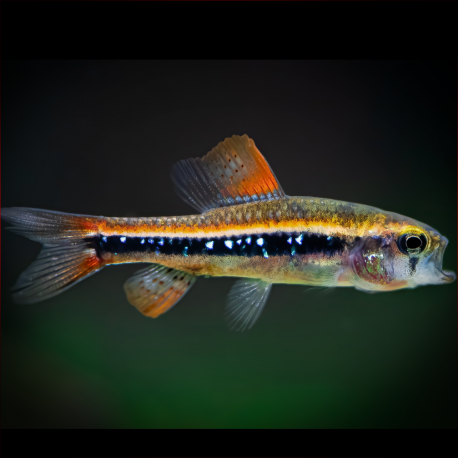More info
Datasheet
| Minimum Tank Size | 40 litres / 10.57 US gallons |
| Maximum Size | 5.0cm / 1.97inches |
| Temperature | 21°C / 69.80°F - 28°C / 82.40°F |
| Hardness | 0.00dgH / 0ppm - 5.04dgH / 90ppm |
| pH | 3.0-6.5 |
General Description
The Black Darter Tetra, also known as the "Black Morpho" tetra, is a micropredator species that feeds on aquatic insect larvae, crustaceans, and worms in its natural habitat. It is not commonly exported in large numbers and requires specialist care, making it a challenging species to keep even for advanced aquarists. This tetra species is part of the Crenuchidae family and lacks an adipose fin, sharing unique characteristics with other closely related species such as P. bovalii.
Aquarium Setup
For optimal care of the Black Darter Tetra, a tank with a soft, sandy substrate is recommended, as the species mainly forages at the bottom. Adding driftwood roots, branches, and dried leaf litter can provide structure and mimic natural conditions. Offering shaded areas through strategic placement of decorations is crucial. Dim lighting, surface vegetation for light diffusion, and aquatic plants like Microsorum or Cryptocoryne spp. are suitable. Stable water conditions with low hardness (0-90ppm), acidic pH (3.0-6.5), and a temperature range of 21-28°C are essential. Adequate filtration, preferably gentle and air-powered, is also necessary, with mature aquarium setups being ideal.
Behaviour
The Black Darter Tetra is not a competitive species despite being predatory and should be the primary focus in a community tank. They are territorial and aggressive towards males of their kind, so maintaining a group with multiple males is recommended to observe their interactions. While they do not form schools, these tetras display territorial behavior and should be kept with similarly-sized, pelagic fish species like Nannostomus or Hyphessobrycon. They should not be housed with benthic or territorial species to prevent aggression.
Feeding and Diet
In captivity, Black Darter Tetras are reluctant to accept dried foods and require daily feeds of live foods such as Daphnia, Artemia, grindal worm, and bloodworm to thrive. Specimens with hollow bellies post-import should be avoided as they often struggle to recover. Their natural diet in the wild consists of aquatic invertebrates and worms, and occasional fish fry.
Reproduction & Dimorphism
Breeding the Black Darter Tetra in captivity is possible with proper setup and care. Males become territorial and colorful during breeding, while females darken with intense red anal fins. Eggs are laid in caves, guarded by the male, and hatch in about 4-5 days. Male care for the fry until they are free-swimming, after which they should be separated to prevent predation. Males can mate with multiple females during incubation, with only some developing extended finnage as they mature. Males are more colorful, slightly larger, and have extended dorsal and anal fins compared to females.
Habitat and Distribution
The Black Darter Tetra is commonly found in slow-moving rainforest streams with tannin-stained water, mud or sand substrates, and abundant leaf litter. Their habitats are shaded by vegetation and have minimal dissolved minerals. These tetras are native to regions in Brazil, Colombia, Peru, and Venezuela, specifically in the upper parts of river drainages like the Rio Negro and Rio Orinoco. Populations from different regions may exhibit variation in coloration and may represent distinct species.

